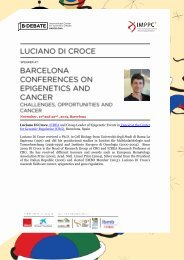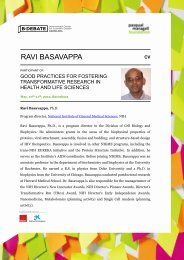Jean-Christophe Paillart - B·Debate
Jean-Christophe Paillart - B·Debate
Jean-Christophe Paillart - B·Debate
You also want an ePaper? Increase the reach of your titles
YUMPU automatically turns print PDFs into web optimized ePapers that Google loves.
Abstract<strong>Jean</strong>-<strong>Christophe</strong> <strong>Paillart</strong>THE HIV-1 VIF PROTEIN: OLIGOMERIZATION, RNA CHAPERONE ACTIVITY ANDMORE …<strong>Jean</strong>-<strong>Christophe</strong> <strong>Paillart</strong>UPR 9002-CNRS, IBMC, Architecture & Reactivity of RNA, University of Strasbourg, 15 rue RenéDescartes, 67084 Strasbourg, FranceThe HIV-1 viral infectivity factor (Vif) is a small basic protein essential for viral fitness andpathogenicity. Vif is required for productive infection of non-permissive cells, where itcounteracts the antiviral activities of the cellular cytosine deaminases APOBEC3G (A3G) andA3F. Several mechanisms have been described to explain the reduction of AG in cells and inviruses: (1) degradation by the ubiquitin-proteasome pathway, (2) translational repression byVif and (3) competition with other RNA/protein binding partners. Moreover, Vif is associatedwith the viral assembly complexes and seems to be packaged into viral particles throughinteractions with the viral genomic RNA and/or the nucleocapsid domain of Gag.To address the role of Vif in viral assembly, we first characterized the impact of alaninesubstitutions in the putative multimerization domain of Vif (161PPLP/AALA164) on Vifoligomerization, secondary structure content and nucleic acids binding properties. Weshowed that wt Vif forms oligomers of 5-9 proteins, while Vif AALA forms dimers and/ortrimers. Up to 40 % of the unbound wt Vif sequence appear to be unfolded, but binding to theHIV-1 TAR apical loop promotes formation of ß-sheets. Interestingly, Vif substitutions do notsignificantly affect its secondary structure, but they diminish its binding affinity and specificity
for nucleic acids. In a second step, we directly studied the oligomerization of Vif in living cellsby using a FRET approach analyzed by FLIM. As expected, we confirmed that Vif-Vifinteractions occur in cells. Interestingly, when Vif is co-expressed together with Gag, Vif islargely re-localized to the cell membrane where Vif oligomerization still occurs. Finally, wetried to identify domains of Vif involved in its RNA chaperoning properties by analyzing theenhancement of in vitro HIV-1 RNA dimerization. We found that the C-terminal region of Vifpossesses this activity. Interestingly, this region has been shown to be disordered suggestingit could easily interact with a range of many different partners. Oligomerization andchaperoning activities of Vif could be important for Vif functions involving RNAs. This work issupported by a grant and fellowships from the French National Agency for Research on AIDS andViral Hepatitis (ANRS) and SIDACTIONSpeaker at:8 th INTERNATIONAL RETROVIRALNC SYMPOSIUMSeptember, 18 th -21 st , 2011, BarcelonaB·DEBATE International Center for Scientific Debate BARCELONA











